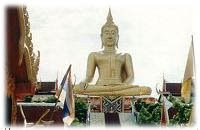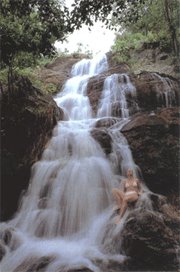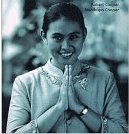Mu Ko Similan

 Similan Archipelago National Park (Mu Ko Similan)
Similan Archipelago National Park (Mu Ko Similan)The park offers extraordinary underwater sightseeing at depths ranging from two to 30 m and it also embraces powdery sand beaches, huge, smooth granite rock formations which plunge into the sea and form seamounts, rock reefs and dive-troughs.
Similan Archipelago National Park consists of a group of 9 petite islands and covers an area of about 130 square kilometers or 80,000 rai. Situated 50 km off the west coast of Phangnga amidst the Andaman Sea, it was designated as a national park on September 1, 1982.
 Sometimes, Ko Similan is referred as Ko Kao, or Nine Islands as the nine of them also has the number as a nickname. Actually, similan is corrupted from the Malay word "sembilan" for nine. From the north to the south, the archipelago comprises Ko Bon, Ko Ba Ngu, Ko Similan, Ko Payu, Ko Miang (actually two islands), Ko Payan, Ko Payang, Ko Ku Yong. They are just petite islands and most of them are uninhabited except for park officials and occasional tourist groups.
Sometimes, Ko Similan is referred as Ko Kao, or Nine Islands as the nine of them also has the number as a nickname. Actually, similan is corrupted from the Malay word "sembilan" for nine. From the north to the south, the archipelago comprises Ko Bon, Ko Ba Ngu, Ko Similan, Ko Payu, Ko Miang (actually two islands), Ko Payan, Ko Payang, Ko Ku Yong. They are just petite islands and most of them are uninhabited except for park officials and occasional tourist groups. Mu Ko Similan has been appraised by Skin-Diving Magazine of the USA as among ten loveliest places in the world. The Similans are also regarded as mainly deep water diving. Their reputation is deserved because of the great beauty of nature discovered on the islands and extensive surrounding coral gardens underwater. The islands are undeveloped and unspoiled. A considerable variety of species of fish, crustaceans, and other marine life flourish. The water in the area is as clear as a glass and excellent for diving.
Mu Ko Similan has been appraised by Skin-Diving Magazine of the USA as among ten loveliest places in the world. The Similans are also regarded as mainly deep water diving. Their reputation is deserved because of the great beauty of nature discovered on the islands and extensive surrounding coral gardens underwater. The islands are undeveloped and unspoiled. A considerable variety of species of fish, crustaceans, and other marine life flourish. The water in the area is as clear as a glass and excellent for diving.Aside from the beautiful natural setting, thirty-two species of birds including resident birds: the Brahminy kite as well as white-breasted waterhen and migratory species of the pintail snipe, gray wagtail, cattle egret, watercock and the roseate tern are to be found on the nine islands. Some of the beautiful islands include:
Similan Island: The largest island among Similan archipelago has the largest granite outcrop shaped like a horseshoe in the north. One can reach the top to see an extensive panorama of the sea. Ko Similan is excellent location for hiking and snorkeling. It encompasses a long curving bay with powdery sandy beaches and wonderful underwater scenery. The water is shallow and beneath the waters coral reefs and colorful fishes abound. Spiny lobsters in rock crevices and sea fans and plume worms can be found in a small bay on the west.
 Miang Island: Miang Island is the second largest island of the archipelago; actually, it is two islands connected. The park office and guesthouses of the Similan Marine National Park are located on the island. Ko Miang is eminent for its beautiful beaches and colorful coral gardens. Scuba gear is not necessary as Ko Miang is perfect for snorkeling and the best location is at the channel between Ko Miang and Ko Payu.
Miang Island: Miang Island is the second largest island of the archipelago; actually, it is two islands connected. The park office and guesthouses of the Similan Marine National Park are located on the island. Ko Miang is eminent for its beautiful beaches and colorful coral gardens. Scuba gear is not necessary as Ko Miang is perfect for snorkeling and the best location is at the channel between Ko Miang and Ko Payu. Ba Ngu or Hua Ka Lok Island: The seventh island in the Mu Ko Similan chain is a rocky island with a strange feature of a skull shape. It is famous for its incredible underwater scenery with colorful fishes, grass and coral reefs. In association with the youngest princess of the present monarch and the Thai navy, an extra effort at environmental protection is made here, and a sea turtle preserve is operated on the island. Ko Ba Ngu is a place where you can see turtles laying their eggs on the white sandy beach.
Ba Ngu or Hua Ka Lok Island: The seventh island in the Mu Ko Similan chain is a rocky island with a strange feature of a skull shape. It is famous for its incredible underwater scenery with colorful fishes, grass and coral reefs. In association with the youngest princess of the present monarch and the Thai navy, an extra effort at environmental protection is made here, and a sea turtle preserve is operated on the island. Ko Ba Ngu is a place where you can see turtles laying their eggs on the white sandy beach.Hu Yong Island: Ko Hu Yong is notable for having the longest white sandy beach in Similan Archipelago. Sea turtles come up to lay their eggs on the beach from November to February.Exactly the same as elsewhere in the Andaman Sea, it is recommended to visit during December to May as the weather is good and the sea is clearest. To get to the park, one can take a boat trip from the pier in Tambon Thap Lamu, Amphoe Takua Pa or from the pier in Amphoe Khura Buri. The trip takes about three hours. Or one can take a boat trip from a pier in Amphoe Kuraburi which also takes about three hours to get to the archipelago.
Basic accommodations are available at the National Park Office on Miang Island and can be reserved at the National Park Division, Forestry Department, Tel +66 2 579 0529, 579 4842 or Mu Ko Similan National Park office Tel +66 76 411913 to 4.


































